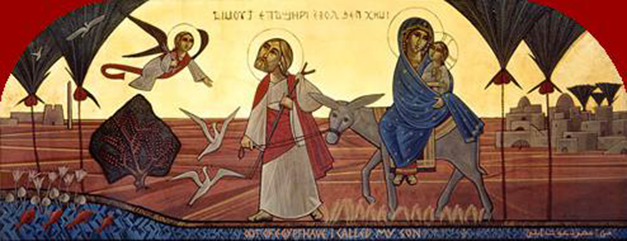Holy Family in Egypt

The Coptic Orthodox Church celebrates the Feast of our Lord’s Entry into Egypt o-n the 24th day of the month of Bashans, which is June 1st Seven Minor Feasts of the Lord.
Following the birth of Our Lord and Savior, Joseph the Carpenter was visited by Archangel Gabriel in a dream, as we see in the Holy Bible. “‘Get up, take the child and his mother, and flee to Egypt, and remain there until I tell you; for Herod is about to search for the child, to destroy him.’ Then Joseph got up, took the child and his mother by night, and went to Egypt, and remained there until the death of Herod. This was to fulfill what had been spoken by the Lord through the prophet, ‘Out of Egypt I have called my son’” (Mt. 2:13-15).
Jesus Christ going into Egypt fulfills Old Testament prophecies including: the Prophet Hosea who said, “Out of Egypt have I called my son”. (Hosea 11: 1); the Prophet Isaiah, “Behold, the Lord rides on a swift cloud, and will come into Egypt, and the idols of Egypt will totter at His Presence, and the heart of Egypt will melt in the midst of it”. (Isaiah 19: 1) and “On that day there will be an altar to the Lord in the center of the land of Egypt… The Lord will make himself known to the Egyptians; and the Egyptians will know the Lord o-n that day, and will worship with sacrifice and burnt offering, and they will make vows to the Lord and perform them… whom the Lord of hosts has blessed, saying, ‘Blessed be Egypt my people’” (Is. 19:19-25).
Egypt was a refuge for many people before the Holy Family. Abraham visited Egypt (Gen. 12:10). Joseph who became the second man after Pharaoh was taken to Egypt. Jacob and his sons came to Egypt where they lived as a family and grew as a nation. Moses, the great prophet, grew up in Pharaoh’s house. St. Stephen says, “And Moses was taught in all the wisdom of the Egyptians, and was mighty in words and in deeds” (Acts 7:22). Moses’ brother Aaron the first chief-priest was born and raised in Egypt. Jeremiah was just one of the prophets who visited Egypt. Thus, Egypt became a representative of the Gentiles to whom Christ came to establish His Church and form His new people.
When the Holy Family entered the land of Egypt, St. Mary the Virgin mother carried the child Jesus in her arms, with Joseph the Carpenter at her side and Salome, who accompanied them. Church scholars and historians suggest that the Holy Family spent a period of about four years in Egypt.
At this time, this was a very difficult journey, filled with many dangers. There were three routes followed by travelers into Sinai from Palestine to Egypt, a crossing which was usually undertaken in groups, for without the protection of well-organized caravans, the ever-present dangers were overwhelming.
But, in their escape from King Herod, the Holy Family had to avoid the well-known routes and traveled guided by God and His Angel.
They carefully traveled day after day, through hidden valleys and across uncharted plateaus in the rugged wastelands of Sinai, enduring the scorching heat of the sun by day and the bitter cold of the desert nights, preserved from the threat of wild beasts and savage tribesmen, their daily sustenance miraculously provided.
And so they arrived safely for God had preordained that Egypt should be the refuge for the One who was to bring the message of peace and love to mankind.
While in Egypt, all the places where the Holy Family passed were blessed. There are many stories of miracles that occurred during the Holy Family’s journey. One example took place in Mataria, where the Holy Family rested under a tree. Near this village, St. Mary and the Lord Jesus Christ rested under a sycamore fig tree while Joseph went into the village. This tree is known to become 60 feet tall. However, the tree bowed down to the ground and gave shade to Saint Mary and our Lord Jesus Christ. Today, the tree is called the Virgin named after Saint Mary.
As spoken of by Isaiah, upon approaching any idols in Egypt, the statues would totter in the presence of the Lord. Paladius, the bishop of Helenopolis and a fourth-century Church historian, wrote an account o-n which he had visited a district of Upper Egypt called El-Ashmoneen, where the Lord Christ was known to have passed by. There, he witnessed the shattered idols, which toppled in the presence of Christ.
The Holy Family could not find any place to rest so they went into this temple in El-Ashmoneen. There were 365 idols in this temple. The people would worship one each day of the year. When they entered the temple, all the idols fell on their faces and broke into pieces. The governor of the city heard the news, and many people expected that he would punish the Holy Family. Instead when he saw the idols fallen, he actually worshipped our Lord and said, “Unless this were the God of our gods, our gods would not have fallen on their faces before Him.” Therefore, all the people believed.
In their return, the Holy Family headed south and took a boat and sailed north along the Nile. The Holy Family’s stay in Egypt provided Egypt with a great blessing like no other place o-n earth
As Christianity in Egypt spread, churches were built throughout the length and breadth of the land, and the sites chosen were, primarily, those which, had been visited and blessed during the Holy Family’s travels.
